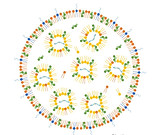
LipidFlex™ Lipid Nanoparticles Kits
for LNP Formulation


Lipid nanoparticles (LNPs) are formulated by the mixing of two phases, an ethanol phase and an aqueous phase. The ethanol phase is a four-component ethanol phase containing ionizable lipid, helper phospholipid, cholesterol, and lipid-anchored PEG. The aqueous phase is an acidic aqueous phase containing payloads such as mRNA, DNA, small molecules, etc. (Learn more about LNP formulation)
LipidFlex™ is a 3-component lipid mixture formulation, which can be directly used to generate liposome for small molecule encapsulation. In addition of different catonic/ionizable lipids, LipidFlex™ can also be used to generate lipid nanoparticles (LNPs) for encapsulation of small molecules and nucleic acid such as mRNA, DNA, protein, etc.
LipidFlex™ T cell kit includes LipidFlex T lipid mix and formulation buffers for high efficient mRNA LNP formulation for T cell transfection.
-
Flexible cationic/ionizable lipid ratio
-
Flexible with various N/P ratio
-
Size: 40-200 nm synthesis
-
PDI: 0.05-0.2
-
Encapsulation Efficiency (E.E.%): >80% (>95-99% w. optimized conditions)
Features:
LipidFlex™ Experiment data:

Features:
LipidFlex™ T Cell Kit is a lipid nanoparticle (LNP) reagent mix. It is a highly efficient lipid formulation used to synthesize mRNA LNP for optimized gene delivery to primary human T cells. Using the NanoGenerator™ Flex-S system and CHIP-MIX-4 cartridge, customers can conveniently prepare potent mRNA LNP with high efficiency.
LipidFlex™ T Cell Kit Performance:

Narrow size distribution of mRNA LNP

High cell viability

High transfection efficiency
High protein expression level

Time efficient synthesis process
LipidFlex™ T Cell Kit Experiment data:

GFP+ 0.003%
GFP+ 96.8%
Negative control
Flow cytometry result showing transfected human T cell using eGFP mRNA LNP.
The graph on the left show the non treated cells (negative control). On the right the treated cells show over 95% of the live human T-cells have been transfected and expressed eGFP in 24 hours.

With PreciGenomes LipidFlex™ T cell kit, the mean fluorescence intensity increased at least 200 fold (blue) compared to the negative control (red).

Protein expression level is dependent on the mRNA LNP dose. This can be seen as the mean fluorescence intensity increases with mRNA dose in T cells.

Over 90% of the cells are alive after the treatment which corresponds to the negative control in human T-cells and Jurkat cells.
Lipid Nanoparticles Formulation Preparation System
for Process & Manufacturing
Lipid nanoparticles or solid lipid nanoparticles (SLNs, sLNPs) are nanoparticles composed of lipids and possess a solid lipid core matrix which is able to solubilize lipophilic molecules. Typically they are spherical with an average diameter between 10 and 1000 nanometers.
Lipid nanoparticles have emerged across the pharmaceutical industry as promising vehicles to deliver a variety of therapeutics. They are a novel pharmaceutical drug delivery system and formulation. LNPs became more widely known in late 2020, as some COVID-19 vaccines that use RNA vaccine technology coat the fragile mRNA strands with PEGylated lipid nanoparticles as their delivery vehicle.
Liposomes, an early version of LNPs, are a versatile nanomedicine delivery platform. A number of liposomal drugs have been approved and applied to medical practice. A liposome is a spherical vesicle with at least one lipid bilayer. The liposome can be used as a vehicle for administration of nutrients and pharmaceutical drugs. Liposomes are composite structures, consisting of phospholipids, especially phosphatidylcholine. It may contain small amounts of other molecules. Though liposomes can vary in size from low micrometer range to tens of micrometers, unilamellar liposomes, shown as the Figure below, are typically in the lower size range with various targeting ligands. The ligands are attached to their surface allowing for their surface-attachment and accumulation in pathological areas for treatment of disease.

Related Products:
Some of Our Customers











